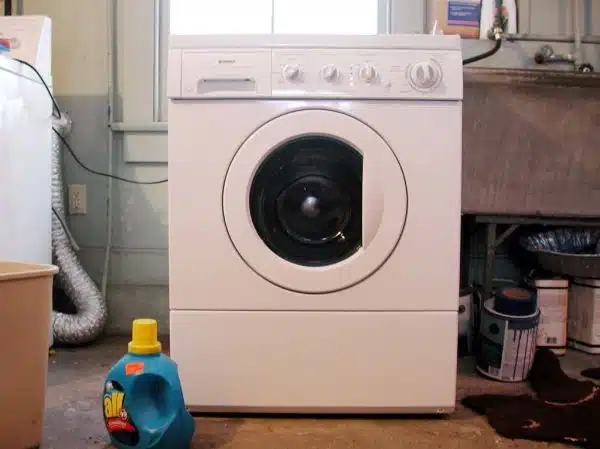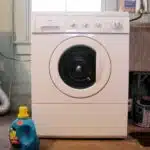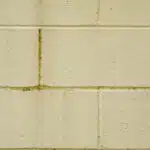When it comes to home appliances, washers and dryers are some of the most frequently used and necessary items in any household. However, over time, these machines can become outdated or worn out, leaving homeowners with the choice of replacing them or finding a way to give them a new lease on life. One easy and cost-effective solution is to paint your washer and dryer.
Painting your washer and dryer can be a simple DIY project that can not only give your appliances a fresh look but also save you money in the process. Additionally, painting your washer and dryer allows you to customize their appearance to match your home’s decor or personal style. In this article, we will provide a step-by-step guide on how to paint your washer and dryer, including materials needed, preparation steps, painting techniques, and tips for ensuring that the paint job lasts for years to come.
Assessing Your Washer And Dryer’s Condition
Have you ever looked at your washer and dryer and thought they could use a refresh? It’s not uncommon for these appliances to become outdated, dingy, or simply in need of a makeover. Before diving into the painting process, it’s important to assess the condition of your washer and dryer. Assessing durability is key, as you want to make sure that it’s worth the effort and investment to paint them. If your appliances are old or in poor condition, it may be more cost-effective to replace them rather than investing time and money into painting.
Assuming your appliances are in good enough condition to paint, the next step is choosing colors that complement your home decor. Many people opt for neutral colors that blend in with their surroundings. However, don’t be afraid to get creative with bold pops of color or patterns if that suits your style better. Keep in mind that the color you choose should also withstand daily use and cleaning without showing wear and tear too easily.
In addition to assessing durability and choosing colors that complement your home decor, there are other factors to consider when painting washers and dryers. The type of paint used is crucial for ensuring long-lasting results. In the next section, we’ll explore different types of paints suitable for this project and how to choose the right one for your specific needs.
Choosing The Right Paint Type And Color
Choosing the right paint type and color for your washer and dryer is crucial to achieve a professional-looking finish. First, consider the type of paint that will work best for your appliances. Epoxy paint is the most durable option as it can withstand high temperatures, abrasions, and chemicals. However, it requires a two-part application process which can be challenging for DIYers. On the other hand, enamel paints are easier to apply but may not provide the same level of durability as epoxy paints.
When it comes to choosing a color for your washer and dryer, you have two options: match them with your existing décor or go bold with a contrasting color. Color matching involves selecting a shade that complements your walls, cabinets, or countertops. This approach creates a cohesive look in your laundry room and makes your appliances blend in rather than stand out. If you want to create an eye-catching statement piece in your laundry room, opt for a bold color like red or navy blue.
DIY paint techniques such as spray painting or brush painting can be used to achieve different textures and finishes on your washer and dryer. Spray painting provides an even layer of paint while brush painting allows you to add depth and texture to surfaces. Whichever technique you choose, ensure that you have all the necessary materials ready before starting.
- Consider using painter’s tape around any areas you don’t want painted.
- Use sandpaper to smooth out any rough spots on the surface before painting.
- Wear protective gear such as gloves and goggles when handling epoxy paint.
- Clean the surface thoroughly before applying any paint.
- Allow ample time for the paint to dry before using your washer or dryer again.
Now that you know how to choose the right paint type and color for your appliances let’s move on to gathering materials and tools needed for this project.
Gathering Materials And Tools
Gathering the necessary materials and tools is an important first step when it comes to painting your washer and dryer. Not only will you need paint, but you’ll also need items like sandpaper, a scraper, and a drop cloth to protect your floors from any spills or splatters. A primer may also be necessary if your washer and dryer are made of metal.
When it comes to choosing paint for your washer and dryer, there are several DIY paint alternatives that can save you money. While appliance-specific paints are available, they can be expensive. Instead, consider using a high-quality enamel paint in the color of your choice. This type of paint is durable and will adhere well to metal surfaces.
While some specialized tools may be helpful when painting your washer and dryer, budget friendly tool substitutions are available. For example, instead of using a spray gun, use a foam roller or brush to apply the paint evenly. Additionally, if you don’t have access to a power sander, sandpaper can be used by hand to prep the surface before painting. By making smart choices about tools and materials, you can successfully complete this project on a budget.
Transitioning into the subsequent section: Before applying new paint to your washer and dryer, it’s essential to remove any existing paint or rust from the surface. This process ensures that the new coat of paint adheres properly and creates a smooth finish. In the next section, we’ll explore how to effectively remove existing paint and rust from your washer and dryer’s surface.
Removing Existing Paint And Rust
Like a phoenix rising from the ashes, a freshly painted washer and dryer can breathe new life into your laundry room. However, before you can begin painting, it is essential to remove any existing paint and rust from the surface of your appliances. This will ensure that the new paint adheres properly and looks its best.
Sandblasting and chemical stripping are two popular methods for removing existing paint and rust. Sandblasting involves using high-pressure sand to blast away the old paint and rust. While this method is highly effective, it can be messy and may require professional equipment. Chemical stripping involves applying a chemical solution to the surface of your appliances, which loosens the old paint and rust so that it can be easily scraped away.
If you decide to use chemical stripping, there are several excellent rust converters available for home use. Rust converters work by chemically converting iron oxide (rust) into iron phosphate, which stabilizes the metal surface and prevents further corrosion. Some of the best rust converters for home use include:
- Rust-Oleum Rust Reformer
- Permatex Rust Treatment
- Loctite Extend Rust Neutralizer
- Evapo-Rust Rust Remover
- Corroseal Water-Based Rust Converter
By removing all existing paint and rust from your washer and dryer using sandblasting or chemical stripping, you can ensure that your new coat of paint will look its best. Once you have removed all old paint and rust from your appliances’ surfaces, the next step is to clean and sand them thoroughly before painting them with a fresh coat of color.
Cleaning And Sanding The Surface
After deciding to paint your washer and dryer, the next step is to clean and sand the surface properly. This is important because it ensures that the paint adheres well to the surface and lasts longer. Before you start cleaning, make sure that your appliances are unplugged and moved to a well-ventilated area where you can work comfortably.
Choosing paint for your washer and dryer is an essential aspect of this project. You need to select a high-quality appliance epoxy spray paint that adheres well, resists chipping, and has excellent adhesion. It would be best if you opted for a durable finish that will withstand regular wear and tear over time. Consider getting a color that matches or complements your decor style.
When it comes to sanding techniques, use fine-grit sandpaper between 220-400 grit to avoid scratching the surface. Sand lightly in circular motions until the surface feels smooth and even. Be careful not to overly sand one spot as it may cause unevenness on the surface. After sanding, wipe down with a damp cloth or tack cloth to remove all dust particles from the surface before painting. The next step is masking off areas that should not be painted, such as knobs, handles, logos, or any other areas where you don’t want paint to stick.
Masking Off Areas That Should Not Be Painted
Imagine you’re an artist, ready to paint a masterpiece. You have your canvas, your paints, your brushes, and your vision. But wait – before you begin, you need to protect certain areas of the canvas that should not be painted. Maybe there’s a tree in the foreground or a figure in the background that needs to be preserved. Without proper masking techniques, you risk ruining your artwork with unwanted paint splatters or smears.
The same is true when painting a washer and dryer. Before you break out the spray paint or brush on some enamel, take the time to mask off areas that should not be painted. This could include knobs, buttons, logos, or other small details that would look messy if covered in paint. Choosing masking tape is essential for this task since it is easily removable and won’t leave behind sticky residue.
When masking off areas of your washer and dryer, it’s important to avoid overspray as much as possible. This means using a light touch with your spray paint or brush and covering surrounding surfaces with drop cloths or newspaper. Overspray can cause unwanted splatters on nearby walls or floors and make cleanup more difficult than it needs to be. By taking your time and being mindful of where the paint is going, you can ensure a clean finish without any messes to clean up later.
With all the necessary prep work complete, it’s time to move on to applying primer to the surface. But before we get into that step, let’s review what we’ve covered so far: choosing masking tape for protecting areas that shouldn’t be painted and avoiding overspray for a cleaner finish. By following these tips and taking care during this process, you’ll set yourself up for success when it comes time to apply the actual coat of paint onto your washer and dryer surfaces.
Applying Primer To The Surface
After masking off the areas that should not be painted, it’s time to move on to the next step in painting your washer and dryer: applying primer. Primer is a critical component of any paint job, as it helps the paint adhere more effectively to the surface and provides a smooth base for the topcoat. In addition, primer can help prevent rust and other forms of corrosion from forming on metal surfaces.
When it comes to choosing a primer for your washer and dryer, there are several types to consider. One option is a general-purpose primer that works well on most surfaces, such as metal or plastic. Another choice is a rust-inhibiting primer that contains special additives designed to prevent rust formation. There are also high-build primers available that can fill in minor imperfections in the surface, creating a smoother finish.
Once you’ve selected your primer type, it’s time to apply it to your washer and dryer. The application technique will depend on the type of primer you’re using, but in general, you’ll want to apply two thin coats rather than one thick coat. This will ensure even coverage and help prevent drips or runs from forming. Be sure to follow any manufacturer instructions regarding drying times between coats or before applying the topcoat. By taking care during this step of the process, you’ll be well on your way to achieving a professional-looking finish when painting your washer and dryer.
Painting The Washer And Dryer
According to a study conducted by the National Association of Home Builders, the average lifespan of a washer and dryer is approximately 10-13 years. However, with proper maintenance and care, these appliances can last even longer. But what if you want to update the look of your laundry room without spending thousands on new appliances? Painting your washer and dryer is a cost-effective way to do just that.
When it comes to painting your washer and dryer, there are many color options available. You can choose from basic colors like white or black, or get creative with bright colors like red or blue. Some people even opt for unique designs such as stripes or polka dots. The possibilities are endless! Just be sure to use paint that is specifically designed for appliances to ensure longevity and durability.
Before painting your washer and dryer, make sure you properly clean and sand down any rough spots or rust. Then, begin applying multiple coats of paint using a small foam roller or paintbrush. This process may take several days depending on how many coats you choose to apply. In the next section, we will discuss applying multiple coats of paint in more detail for those looking to tackle this project themselves.
Applying Multiple Coats Of Paint
- Before painting a washer and dryer, it is important to properly prepare the surface. This includes cleaning the appliance, removing hardware, and filling any dents or holes.
- The first coat of paint can be applied with a brush or roller. It is important to use even strokes, ensuring that the entire surface is covered.
- After the first coat has dried, it should be lightly sanded with a fine grit sandpaper. This will help to ensure a smooth finish.
- A second and third coat of paint should be applied, ensuring that each coat is completely dry before applying the next.
- Between each coat of paint, the surface should be lightly sanded to remove any bumps or ridges that may have formed.
- Once all coats of paint have been applied, the washer and dryer should be allowed to dry completely before being used.
Preparing For Painting
Before embarking on the task of painting your washer and dryer, it is essential to prepare the surfaces properly. You need to clean and dry the machines thoroughly to ensure that the paint adheres well and lasts for a long time. Begin by wiping down the exterior of the machines with a mild detergent solution to remove any dirt, grease, or dust. After that, rinse them off with clean water and let them air-dry completely.
Once you have cleaned your washer and dryer, you need to choose the colors you want to use. You may want to match the color of your appliances with that of your walls or other home decor items. Alternatively, you could opt for bright colors that add a pop of personality to your laundry room. Whatever color scheme you choose, make sure that it complements your overall home decor style.
After completing surface preparation and choosing colors, it’s time to start painting. But before starting, make sure you have all the necessary supplies such as primer and high-quality paint designed specifically for metal surfaces. Follow manufacturer instructions when applying coats of paint on top of each other until you get an even finish. Remember not to rush through this process; take your time so that you get an excellent quality finish that will last for years without fading or peeling.
Painting The First Coat
Now that you have completed the surface preparation and chosen your desired colors, it’s time to start painting. The first step is to apply a coat of primer to the washer and dryer surfaces to ensure that the paint adheres well and lasts longer. You can use a spray primer or a brush-on primer depending on your preference. When applying the primer, make sure that you do so in thin, even coats, and let each coat dry completely before applying another layer.
Once the primer has dried completely, it’s time to apply the first coat of paint. Begin by painting the areas that are harder to reach with a small brush before moving onto larger areas with a roller or a sprayer. When using a roller or sprayer, work in sections and avoid overloading them with too much paint as this can lead to drips or unevenness in your finish. When choosing colors for your first coat, consider using light shades if you plan on adding multiple coats of paint.
When applying techniques for painting multiple coats, make sure that each layer dries completely before adding another one. Depending on the type of paint you are using and environmental conditions such as humidity levels in your laundry room, this could take several hours or even days. Take care not to rush through this process as it will affect the overall quality of your finish. After applying multiple layers of paint, inspect your work carefully for any missed spots or imperfections and touch them up as necessary until you achieve an even finish free from blemishes.
Applying Final Coats
After applying multiple coats of paint, you’re getting closer to achieving a professional-looking finish for your washer and dryer. However, the final coat is just as important as the previous ones to ensure that your appliances are both functional and aesthetically pleasing. When selecting colors for your final coat, consider using darker shades as they tend to hide imperfections better than lighter ones.
Before applying the final coat, make sure that the previous layers have dried completely. This will prevent any unwanted smudges or marks on your work. You can use either a brush or roller to apply the final coat depending on your preference. If you’re using a brush, choose one with high-quality bristles to avoid leaving streaks in your finish. On the other hand, rollers are excellent at covering large areas quickly but can sometimes leave bubbles in their wake.
Once you’ve applied the final layer of paint, inspect your work carefully for any flaws or missed spots. If necessary, touch up these areas until you achieve an even finish free from blemishes. After everything has dried completely, it’s time to reattach any hardware or accessories that may have been removed earlier in the painting process. With proper care and maintenance, your painted washer and dryer should last for several years while looking brand new all along!
Allowing Sufficient Drying Time
To achieve a professional-looking finish for your newly painted washer and dryer, it’s important to allow sufficient drying time before handling or using the appliances. Tips for ensuring proper drying include checking the manufacturer’s instructions for recommended drying times and avoiding high humidity areas. It’s also crucial to ensure proper ventilation during the drying process.
One of the most important tips for allowing sufficient drying time is to check the manufacturer’s instructions for recommended drying times. Different types of paint and surfaces may require different amounts of time to dry properly, so be sure to follow these guidelines closely. Additionally, avoid handling or using your appliances until they are fully dry in order to prevent smudging or damage to the paint.
Proper ventilation during the drying process is also essential. Make sure that the room you’re painting in has good air circulation, either with an open window or a fan. Avoid painting in humid conditions or during rainy weather, as this can slow down the drying process and lead to uneven results. By following these tips, you can ensure that your painted washer and dryer have a smooth, even finish that will last for years to come.
As you wait for your washer and dryer to dry completely, it’s a good time to start thinking about removing masking tape and touching up edges. Properly removing masking tape without damaging your newly painted surface is important for achieving a professional-looking finish. In the next section, we’ll go over some tips for safely removing masking tape and touching up any rough edges that may have been created during the painting process.
Removing Masking Tape And Touching Up Edges
After allowing sufficient drying time, it is now time to remove the masking tape and touch up any edges that may have been missed. Before doing so, make sure to inspect the painted surface for any inconsistencies or blemishes.
Blending colors is an essential step in ensuring a professional-looking finish. If there are any areas where the paint has overlapped, use a fine-grit sandpaper to gently blend the colors together. This will create a seamless transition between colors and eliminate any noticeable lines.
When touching up edges, it is important to be mindful of preventing paint drips. Use a small brush and apply thin coats of paint rather than attempting to cover large areas with one thick coat. If you do notice any drips, quickly remove them with a dry brush or cloth before they dry and become permanent.
Now that the washer and dryer have been painted and touched up, it’s time to reassemble them. But before doing so, make sure all components are thoroughly dry and free of dust or debris that could potentially damage the newly painted surface. With careful attention to detail throughout each step of the process, your washer and dryer will look brand new again in no time!
Reassembling The Washer And Dryer
With the painting process completed, it is now time to reassemble your washer and dryer. Reassembling your appliances can be a daunting task, but with the right techniques and tips, you can make the process smoother. One thing to keep in mind when reassembling is to carefully follow the disassembly steps in reverse order.
When reassembling your washer and dryer, it’s important to take note of any bolts or screws that may have been lost or misplaced during the disassembly process. Common mistakes during reassembly include missing bolts or screws, incorrect wiring connections, and forgetting to attach certain components. To avoid these mistakes, double-check each step as you go along.
Reassembly challenges may arise if some parts are not fitting correctly or if some components are damaged during the painting process. If this happens, don’t force anything into place as it may cause further damage. Instead, take a step back and try to identify what’s causing the issue before proceeding. With patience and attention to detail, you’ll be able to overcome any challenges that arise during reassembly.
As you finish up reassembling your washer and dryer, it’s important to remember that caring for them properly will ensure their longevity. In the next section, we’ll discuss some tips on how to care for your newly painted appliances.
Caring For Your Newly Painted Appliances
Now that you’ve successfully painted your washer and dryer, it’s important to take care of them properly to ensure they last as long as possible. One way to do this is by applying a protective coating over the paint. This will help prevent chipping and fading, as well as make cleaning easier. You can find protective coatings specifically designed for appliances at most hardware stores.
In addition to using a protective coating, there are some simple maintenance tips you can follow to keep your newly painted appliances looking great. First, avoid using abrasive cleaners or scrubbers when cleaning them. These can scratch the paint and cause it to peel off over time. Instead, use a soft cloth or sponge and mild dish soap to wipe down the surfaces.
Another important step in caring for your newly painted washer and dryer is to be mindful of how you load them. Avoid placing sharp objects or heavy items directly against the painted surfaces, as these can cause scratches or dents. If possible, try to distribute the weight evenly throughout the machine.
- Apply a protective coating over the paint
- Look for coatings specifically designed for appliances
- Apply according to manufacturer instructions
- Use mild cleaners and avoid abrasive scrubbers
- Use a soft cloth or sponge instead
- Avoid harsh chemicals that may damage the paint
- Be mindful of how you load your appliances
- Avoid placing sharp objects or heavy items against painted surfaces
- Try to distribute weight evenly throughout the machine
With these simple maintenance tips and proper use of a protective coating, your newly painted washer and dryer will stay looking great for years to come. However, if any issues do arise with your appliances, don’t worry! In the next section, we’ll go over some common troubleshooting techniques that can help resolve any problems quickly and easily.
Troubleshooting Common Issues
As the saying goes, “A job worth doing is worth doing well.” After all the hard work you’ve put into painting your washer and dryer, the last thing you want is for it to start peeling or discoloring. Fortunately, there are a few things you can do to prevent these common issues.
Firstly, preventing peeling starts with proper preparation. Make sure that your surfaces are clean and dry before painting. Any dirt or debris can cause the paint to peel or bubble. Additionally, ensure that you use a high-quality primer that will adhere well to metal surfaces. Without a good primer, the paint may not stick properly and could easily peel.
Secondly, avoiding discoloration requires proper ventilation during the painting process. If fumes build up in an enclosed area, they can cause yellowing of the paint over time. To avoid this issue, make sure that you have plenty of fresh air circulating throughout your workspace while painting. You may also want to consider using low-VOC (volatile organic compound) paints which emit fewer harmful gases than traditional paints.
By taking these preventative measures, you can enjoy your freshly painted washer and dryer for years to come without any peeling or discoloration issues. In our next section, we’ll discuss some final tips for finishing up your project and making sure everything looks perfect.
Enjoying Your Freshly Painted Washer And Dryer
Now that your washer and dryer have been given a fresh coat of paint, it’s time to enjoy the fruits of your labor. Here are some tips on how to maximize the benefits of your newly painted appliances.
Showcase them in your laundry room: Your repainted washer and dryer can be a great centerpiece in your laundry room. Add some DIY decorating ideas to make the space even more inviting.
Keep them clean: Maintenance is key to keeping your appliances looking their best. Wipe them down regularly with a damp cloth, and avoid using abrasive cleaners or scrubbers.
Protect the paint: To ensure the longevity of your new paint job, consider applying a clear coat or wax over the surface for added protection.
Show off your work: Share photos of your newly painted washer and dryer on social media platforms like Pinterest or Instagram, and inspire others to tackle their own DIY projects.
Incorporating these tips into your home maintenance routine will help you get the most out of your freshly painted appliances. Not only will they look great, but they’ll also function just as well as before. So sit back, relax, and enjoy the results of all your hard work!
Conclusion
Painting your washer and dryer is a great way to give your laundry room a fresh new look. Before starting, assess the condition of your appliances to ensure that they are suitable for painting. Choose the right paint type and color that will complement your laundry room’s design. Gather all the necessary materials and tools, and remove any existing paint or rust before cleaning and sanding the surface.
Once you have painted your washer and dryer, reassemble them carefully and take proper care to maintain their newly painted appearance. In case of common issues such as chipping, flaking or fading of paint, troubleshoot by following our tips. Finally, enjoy your freshly painted washer and dryer as if it were a brand new appliance in your home.
Painting a washer and dryer may seem like an intimidating task at first but with these steps, it can be done with ease. It’s similar to painting a blank canvas where creativity can flow freely. Just like how an artist takes pride in their work, you too will take pride in completing this DIY project knowing that you’ve added beauty to an otherwise mundane appliance. Give your laundry room the makeover it deserves by painting your washer and dryer today!
Image Credits
- “Washer” by Editor B (featured)





























